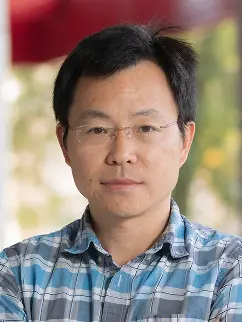There are a lot of reasons why artificial intelligence burst into the mainstream in the last few years—but one of the biggest factors has been the rapid advancement of graphics processing units, or GPUs. These computer processors are particularly good at handling the types of mathematical and parallel computing tasks that make AI possible.
As it turns out, the GPU revolution isn’t just good for chatbots and machine learning algorithms. The investment in these specialized processors has also enabled a huge leap forward in optics and photonics, leading to faster and better designs for devices used in internet connections, data centers, cameras, screens and displays, virtual reality headsets, and many other types of electronics.
 Zongfu Yu
Zongfu Yu
In an invited article in Optics and Photonics News, Zongfu Yu, the Grainger Professor in electrical and computer engineering at the University of Wisconsin-Madison, and colleagues explore the way faster GPUs are accelerating complex simulations used to design photonic devices.
“Over time, faster processing has actually changed the entire landscape of AI; it’s unrecognizable from 15 years ago,” says Yu. “We believe the same thing will happen to photonics—in the sense that once you accelerate the computing, you could come up with novel designs to solve some of the toughest engineering problems, and you will iterate your designs 100 times faster. It will enable fundamentally new capabilities.”
The same optimization that makes GPUs good for AI processing also makes them great for optics and photonics simulations, which are incredibly complex. Previously, Yu says, researchers would design a photonic circuit, then “spot-check” its functionality by running one or two simulations (which would take days) to see if the circuit might function properly. Now, with GPU-powered simulations, which take about 10 minutes, it’s possible to check designs and make modifications over and over during the design process. “That changes the entire workflow of how people design these kinds of practical devices, and also opens new possibilities for achieving better performance,” says Yu.
The researchers say they don’t see the processing needs of AI and their field diverging anytime soon, meaning they are happy to piggyback on the hundreds of billions of dollars invested in AI computing for the foreseeable future.
Yu says the next step is to also use the power of GPUs to enable automatic optimization of optical and photonic devices. That way, researchers can rapidly iterate their designs—guided by computers, rather than intuition. But it will require engineers like Yu and his colleagues to develop new platforms and automated workflows to take advantage of the hardware.
While the GPU revolution is particularly good for his field right now, Yu says that eventually he thinks it could lead to similar advances in other engineering disciplines that rely on complex design simulations, including computational fluid dynamics, thermal engineering, structural engineering and many others. “We will see these engineering models evolve similarly to AI models,” he says. “They’re going to be automatically optimized by computer and deliver a new paradigm of generative product design.”
Other authors include Professor Shanhui Fan from Stanford University, Momchil Minkov from Flexcompute, Inc., and Peng Su and Ben Lee from Nvidia.
Featured image caption: The rapid advancement of GPUs, like the one pictured, are enabling the current boom in AI, and also leading to a revolution in optics and photonics device design. Credit: iStock.